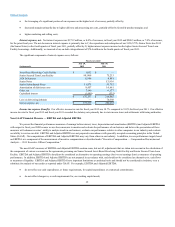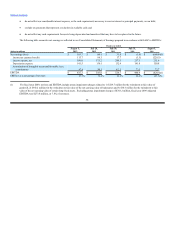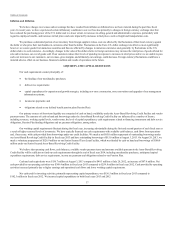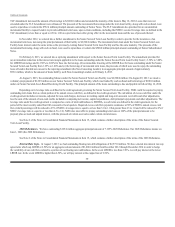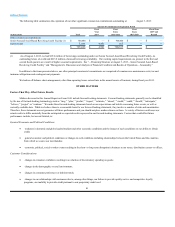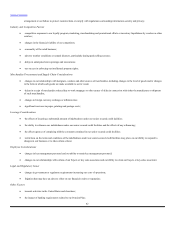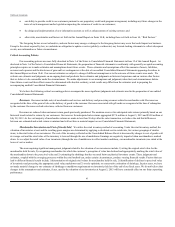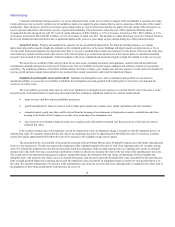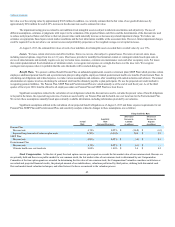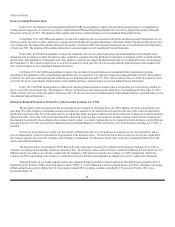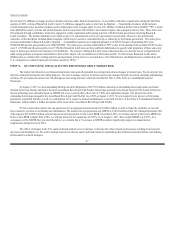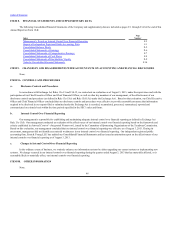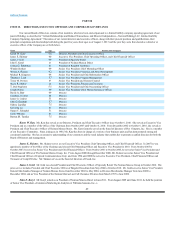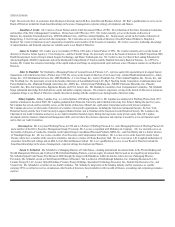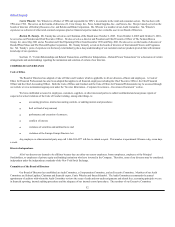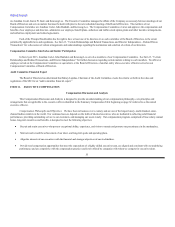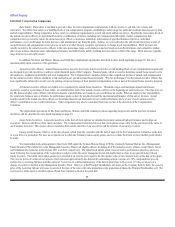Neiman Marcus 2012 Annual Report Download - page 47
Download and view the complete annual report
Please find page 47 of the 2012 Neiman Marcus annual report below. You can navigate through the pages in the report by either clicking on the pages listed below, or by using the keyword search tool below to find specific information within the annual report.
Table of Contents
fair value over the carrying value by approximately $305 million. In addition, we currently estimate that the fair value of our goodwill decreases by
approximately $254 million for each 0.25% increase in the discount rate used to estimate fair value.
The impairment testing process related to our indefinite-lived intangible assets is subject to inherent uncertainties and subjectivity. The use of
different assumptions, estimates or judgments with respect to the estimation of the projected future cash flows and the determination of the discount rate used
to reduce such projected future cash flows to their net present value could materially increase or decrease any related impairment charge. We believe our
estimates are appropriate based upon current market conditions and the best information available at the assessment date. However, future impairment charges
could be required if we do not achieve our current revenue and profitability projections or the weighted average cost of capital increases.
At August 3, 2013, the estimated fair values of each of our indefinite-lived intangible assets exceeded their recorded values by over 35%.
Leases. We lease certain retail stores and office facilities. Stores we own are often subject to ground leases. The terms of our real estate leases,
including renewal options, range from two to 121 years. Most leases provide for monthly fixed minimum rentals or contingent rentals based upon sales in
excess of stated amounts and normally require us to pay real estate taxes, insurance, common area maintenance costs and other occupancy costs. For leases
that contain predetermined, fixed calculations of minimum rentals, we recognize rent expense on a straight-line basis over the lease term. We recognize
contingent rent expenses when it is probable that the sales thresholds will be reached during the year.
Benefit Plans. We sponsor a defined benefit Pension Plan, an unfunded supplemental executive retirement plan (SERP Plan) which provides certain
employees additional pension benefits and a postretirement plan providing eligible employees limited postretirement health care benefits (Postretirement Plan). In
calculating our obligations and related expense, we make various assumptions and estimates, after consulting with outside actuaries and advisors. The annual
determination of expense involves calculating the estimated total benefits ultimately payable to plan participants. We use the projected unit credit method in
recognizing pension liabilities. The Pension Plan, SERP Plan and Postretirement Plan are valued annually as of the end of each fiscal year. As of the third
quarter of fiscal year 2010, benefits offered to all employees under our Pension Plan and SERP Plan have been frozen.
Significant assumptions related to the calculation of our obligations include the discount rates used to calculate the present value of benefit obligations
to be paid in the future, the expected long-term rate of return on assets held by our Pension Plan and the health care cost trend rate for the Postretirement Plan.
We review these assumptions annually based upon currently available information, including information provided by our actuaries.
Significant assumptions utilized in the calculation of our projected benefit obligations as of August 3, 2013 and future expense requirements for our
Pension Plan, SERP Plan and Postretirement Plan, and sensitivity analysis related to changes in these assumptions, are as follows:
Using Sensitivity Rate
(Decrease)/ (Decrease)/
Sensitivity Increase in Increase in
Actual Rate Liability Expense
Rate Increase/(Decrease) (in millions) (in millions)
Pension Plan:
Discount rate 4.70%0.25%$ (16.8) $ (0.3)
Expected long-term rate of return on plan assets 6.50%(0.50)% N/A $1.9
SERP Plan:
Discount rate 4.50%0.25%$(3.0) $ 0.1
Postretirement Plan:
Discount rate 4.70%0.25%$(0.3) $ —
Ultimate health care cost trend rate 8.00%1.00%$1.6 $0.2
Stock Compensation. At the date of grant, the stock option exercise price equals or exceeds the fair market value of our common stock. Because we
are privately held and there is no public market for our common stock, the fair market value of our common stock is determined by our Compensation
Committee at the time option grants are awarded. In determining the fair value of our common stock, the Compensation Committee considers such factors as
our actual and projected financial results, the principal amount of our indebtedness, valuations performed by third parties, utilizing both discounted cash
flow and market-based valuation techniques, and other factors it believes are material to the valuation process.
45


